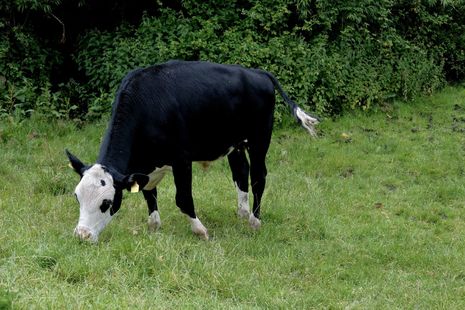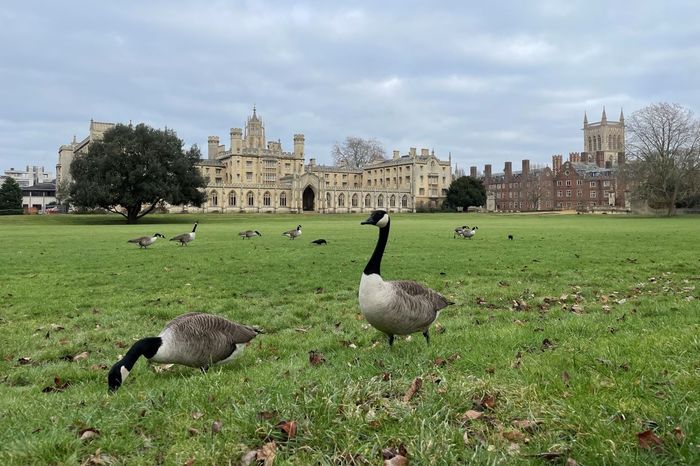Cambridge’s uddergraduates: The cows that roam our city
Lola Frisby Williams investigates why the beloved Cambridge cows are here, and what happens to them when they disappear

A nice stroll along the River Cam is one of the great pastimes of a Cambridge resident, particularly in the summer months. Wildflowers lace the paths between historic buildings, and ducks quack contentedly on the riverbanks. Unusually – for so central a city – our walks along the river are also shared with some larger inhabitants, namely the cattle herds that roam the Commons. Perhaps you’ve steered clear of them on a cycle to Grantchester or picked out their russet hides among the grasses in front of King’s College. They are largely unbothered by passers-by, content in their grazing.
Cambridge’s cows follow in the tradition of ‘Commons grazing’, a regular practice in cities across the country before the 17th century. ‘Common’ land can be accessed by anyone, and everyone is granted certain rights on how they can use it. This includes the right to graze livestock. Though it follows an ancient tradition, the cattle grazing that happens in Cambridge today is slightly more high-tech.
“Cattle grazing has many benefits for the biodiversity of the area”
I spoke with Angelika von Heimendahl, who has been grazing cattle in Cambridge for almost twenty years. Her herd at Coe Fen are kitted out with large cowbell-like collars containing GPS trackers. These allow Angelika and members of the council to track the whereabouts of the cows and implement targeted grazing. Cattle grazing has many benefits for the biodiversity of the area; it’s a gentler way of keeping the Commons’ grass in check while supporting species of beetles and insects, and it keeps non-native plants under control.
To allow the cattle the freedom to graze without them escaping or munching on rare flowers, “virtual fences” have been set up via these collars. A loud alarm is emitted when the cows go near this virtual fence, prompting them to change direction. The GPS trackers also mean that any escapees can be tracked down easily. However, the lack of a physical fence does mean a few cows make it into the river every year, prompting a response from a specially-trained council team known as the “pinder service”.
Angelika mostly keeps Red Polls, a local breed good for meat and milk. “Poll” refers to the fact that they are born without horns. And though we may walk past these cows and avoid thinking about where they will end up, they don’t go far: you can buy Cambridge beef at the market on a Sunday at Angelika’s CamCattle stall.
While the cows are a staple of the city through spring and summer, they suddenly disappear in the winter months. Angelika explained to me that they are sent to what she terms a “bed and breakfast” at a farm near Royston. They are kept indoors and fed local silage (a kind of moist and fermented hay). If left on the Commons over the winter, the repeated weight of the cows’ hooves pressing into wet ground creates unfavourable conditions for both locals and the cows themselves.
Yet while the cows roam Cambridge as part of a sustainable farming strategy, their impact goES far beyond their contribution to the dinner plate: “One of them just came over and tried to eat my bike lock”, Yifei told me. He’d just finished his exams and was relaxing in the sun by Coe Fen. “I don’t really care, Cambridge is a city with lots of green spaces and the cows being here really represents that.” Yifei is one of many students I have spoken to who are more than happy to share the city with these animals.
“Steak is one of life’s great pleasures!”
While on a mission to investigate the cows for myself, I spotted two gentlemen on a stroll along the river, coffee cups in hand. They are unperturbed by the herd just metres away. I stopped them to ask their opinions on Cambridge’s cows. “They’re beautiful,” one said. I asked if their opinions changed when they learned they could buy the meat of these cows at the market on a Sunday. “Well, steak is one of life’s great pleasures!” he remarked.
This is of course the uncomfortable truth about the fate of the cows, but their life cycle raises an important point about our food sourcing. A few students I spoke to remarked that they wouldn’t want to buy their beef at the market. It’s strange, that we can see these cows and share the city with them but be so averse to connecting them to what we eat. Is it not better to know that these cows are having a good life and are not shipped thousands of miles to reach our tables? Angelika highlighted how buying from CamCattle is an ethical and sustainable option; you can see the quality of the living conditions of these animals for yourself every day in the spring and summer seasons, and the entire life cycle of the cows happens within a few miles of the market stall.
Angelika also pointed out to me that the University Catering Service has a ‘Sustainable Food Policy’ which includes the removal of lamb and beef from the menus of 14 food outlets across the University. She was unconvinced this is wholly effective; it seems like a strong, bold move, but in reality the University buys through a syndicate for our food. They prioritise only the cost and not the locality, quality nor sustainability of suppliers. As Angelika mentioned, the University could make a huge difference in Cambridgeshire and beyond by buying from local suppliers. It would be far more impactful than simply blanket-banning beef and lamb. In fact, obtaining ethically sourced beef and lamb is comparably easy as they can be grazed outdoors for most of the year.
We don’t all have to go vegan to be able to make a difference through our diet. “The UK is good at growing grass. We are not good at growing tomatoes. So having the cows eat the grass turns it into something that we can use for energy. It is the natural cycle,” Angelika said.
Cambridge’s cows provide a rustic countryside feel to a busy city and connect to a tradition hundreds of years old. They are not just an ornament but a functioning part of our food chain and local economy. In an age when we can be so disconnected from what we buy and consume, Cambridge’s cows can provide a visual reminder of the ‘natural cycle’, prompting us to ask questions about the origins of what we eat.
 News / Cambridge academics stand out in King’s 2026 Honours List2 January 2026
News / Cambridge academics stand out in King’s 2026 Honours List2 January 2026 Interviews / You don’t need to peak at Cambridge, says Robin Harding31 December 2025
Interviews / You don’t need to peak at Cambridge, says Robin Harding31 December 2025 News / AstraZeneca sues for £32 million over faulty construction at Cambridge Campus31 December 2025
News / AstraZeneca sues for £32 million over faulty construction at Cambridge Campus31 December 2025 News / News in Brief: Maypole mentions, makeovers, and moving exhibits4 January 2026
News / News in Brief: Maypole mentions, makeovers, and moving exhibits4 January 2026 Features / “It’s a momentary expression of rage”: reforming democracy from Cambridge4 January 2026
Features / “It’s a momentary expression of rage”: reforming democracy from Cambridge4 January 2026










